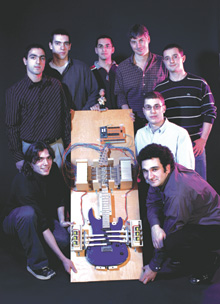Start me up, it's RoboKeith! Students design a guitar

Clockwise from bottom left: Steve Kiss, Pooyan Haghighat, Omur Kalkan, Andrew Ghattas, Ted Obuchowicz, Konstantinos Vitoroulis, Hadley Myers and Niladri Roy. This article and photo were adapted from the ENCS quarterly magazine.
Photo by Marc Bourcier
RoboKeith is an electric guitar that plays under microprocessor control. Besides the guitar and microprocessor, it utilizes some input/output circuitry, solenoids, and software. Put them all together and what you have is a robotic homage to famed Rolling Stones guitarist Keith Richards.
RoboKeith started with a group of Electrical and Computer Engineering students who share a passion for music.
Two final-year electrical students approached Ted Obuchowicz, wanting to do a project that would combine their musical interests with their engineering and electronics knowledge. Ted, an ECE instructor, is well known in ECE as a fan of the legendary rock group the Rolling Stones.
The initial idea was to build a robotic mechanism that would play a musical keyboard. Player pianos, musical devices that can play without human intervention by mechanical, pneumatic, or electrical means, have been around for over a century, so a newer technology seemed more interesting.
Ted suggested replacing the keyboard with a guitar. Besides presenting more difficult design obstacles to overcome, Ted said, “It’s cooler, and more rock n’ roll.” The two students agreed, and three more students joined the team.
The microprocessor controls the activation of electromagnetic solenoids, which depress and strum strings of the electric guitar. The information regarding which strings to depress and which strings to either pluck or strum is obtained from the microprocessors memory unit.
The binary information stored in the memory is obtained from several sources. One is the output of a custom piece of software that accepts files in MIDI (Musical Instrument Digital Interface) format and transforms it into a format used by the microprocessor to control the solenoids.
Another input is through a graphical user interface via a personal computer. A user can select notes or chords to be played in succession and the guitar will then play the selected musical elements on its own.
Five out of the six student team members play guitar. Steve Kiss has a music technology degree from Vanier College and is writing the software that parses the MIDI file input into a form readable by firmware.
The current incarnation of RoboKeith is limited to the first four frets on the neck of the guitar, hence the need for the parser to transpose notes in the MIDI file down to their equivalent notes as they would be played on the first four frets. This requires knowledge of music theory.
The other group members were primarily responsible for the design and construction of the electromechanical mechanism that performs the important fretting and plucking of the guitar strings.
Other aspects of the design called for a microprocessor to control the operation of the guitar and custom input output circuitry that controls the operation of the solenoids.
The project embodies knowledge from various disciplines of electrical and computer engineering, including microprocessor programming and software engineering interfaces. There is also a mechanical design component.
The group members are quite proud of the fact that they were able to do this on their own, which speaks to their hard work and to the preparation their ECE program provides. A great deal of thought went into the design of the software which transforms a MIDI file into an intermediate format used by the microprocessor to control the solenoids.
RoboKeith has undergone initial testing and can now play songs on its own, albeit somewhat primitive ones. RoboKeith fans are waiting to hear it play some classic Rolling Stones songs. The one most appropriate in this case would be Start Me Up.